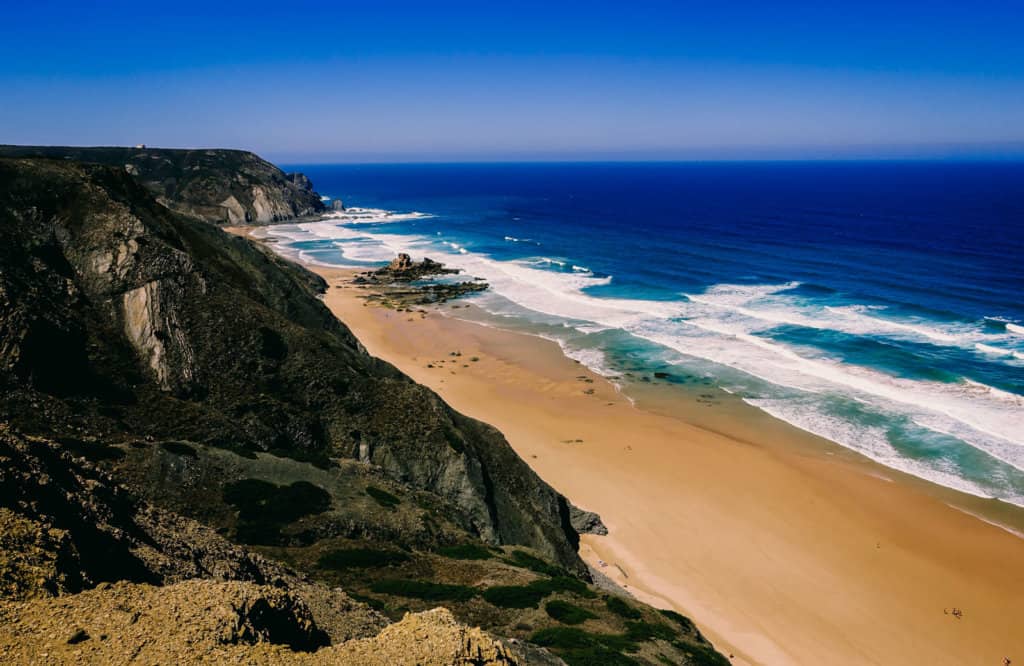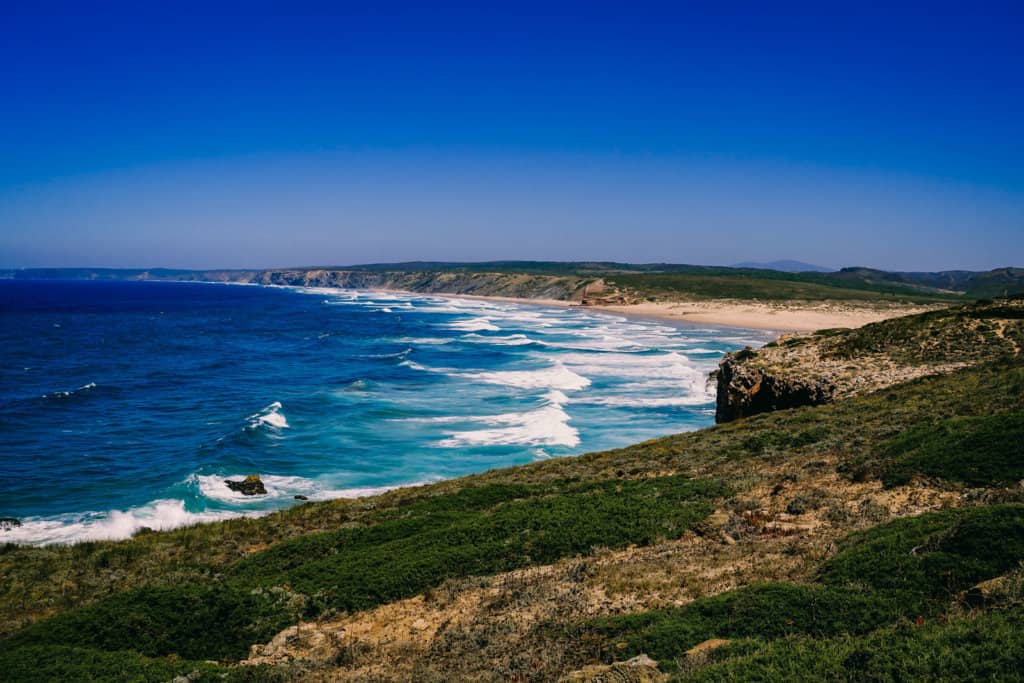Road trip | Portugal | Western Europe
The best of Portugal in 10 days - Itinerary and Travel Guide
Text | Anninka Kraus
Photography | Tobias Kraus

Portugal
Portugal is diverse, rich in culture, and boasts an abundance of historical treasures, marvellous hilltop villages, enchanting medieval castles, amazing food, wild and deserted beaches, and a vibrant, welcoming spirit.
Also, the country is the perfect size to visit in the space of ten days without feeling rushed. Starting in Lisbon where most international visitors arrive, our road trip itinerary takes you on a round trip up the coast to Porto and the terraced vineyards of the Duoro Valley, then ventures inland across the Serra da Estrela mountain range and south towards the Algarve.
“Lisbon or Barcelona?” I had asked friends of ours, whom I knew had been to both, for their preference of these two cities. Admittedly it’s a rather silly question to ask, like making someone choose between chocolate and ice cream, as you want both.
But on a 10-day long vacation coming up, we could either do a road trip through Spain or Portugal, but not both, and we’d wanted to visit Lisbon and Barcelona for years anyway. I was hoping our friends would have an opinion on the matter, helping us choose, and they did indeed.
jump ahead.
Visit these places on your 10-day Portugal road trip.
our favourite restaurants, shops, and cafes
Manteigaria – Some of the best pastéis de nata in town
Clube de Jornalistas – Classy food in tree-lined inner courtyard decorated with fairy lights
Restaurante Psi – Vegetarian and vegan fusion food in serene garden setting with live sitar music
Maruto Bar & Bistro – Tapas bar Rua Do Cais de Santarem 30
Embaixada – Boutique shops with mostly young or up-and-coming Portuguese designers
Pastéis de Belém – Famous for its Pastéis de Belém (pastel de nata)
Casa Piriquita – Local pastries and sweets – queijadas and travesseiros
A Sandeira – As they state on their homepage, ‘best sandwiches in Porto’
Nata Lisboa – Delicious pastéis de nata
Confeitaria do Bolhao – Pastries
Largo do Paco – Michelin star restaurant
Casa das Penhas Douradas – Mountain resort
Burel Factory – Buy handcrafted woollen blankets, cushion covers, or garments from one of the last existing wool factories of Manteigas and join a guided tour of the factory
Portugal 10-day itinerary
- Day 1
- Stroll the cobbled alleyways of Lisbon lined by colourful houses with lustrous, picturesque facades.
- Day 2
- Hop on one of the traditional yellow trams and discover the many miradouros (viewpoints) scattered across the seven hillsides overlooking the dense urban sprawl of red terracotta roofs.
- Day 3
- Go to Belém and visit the Mosteiro dos Jerónimos, a monastery of the 16th century adorned with elaborate ornaments – delicate statues, gables, pinnacles, cherubs, and arches.
- Day 4
- Day trip to Sintra, the former fairytale summer retreat of the Portuguese royals and governing elite.
- Day 5
- Travel to Porto, the second largest Portuguese city that sprawls on the sloping hillside rising from the Duoro River.
- Day 6
- Visit the Duoro Valley with its terraced vineyards gently sloping up the valley.
- Day 7 and 8
- Relax at the Casa das Penhas Douradas in the mountain range between Manteigas and Seia.
- Day 9
- Drive to Vila do Bispo at the very southwestern tip of the Algarve, stopping in Évora on the way to see the Templo Romano.
- Day 10
- Discover the Algarve’s most stunning beaches
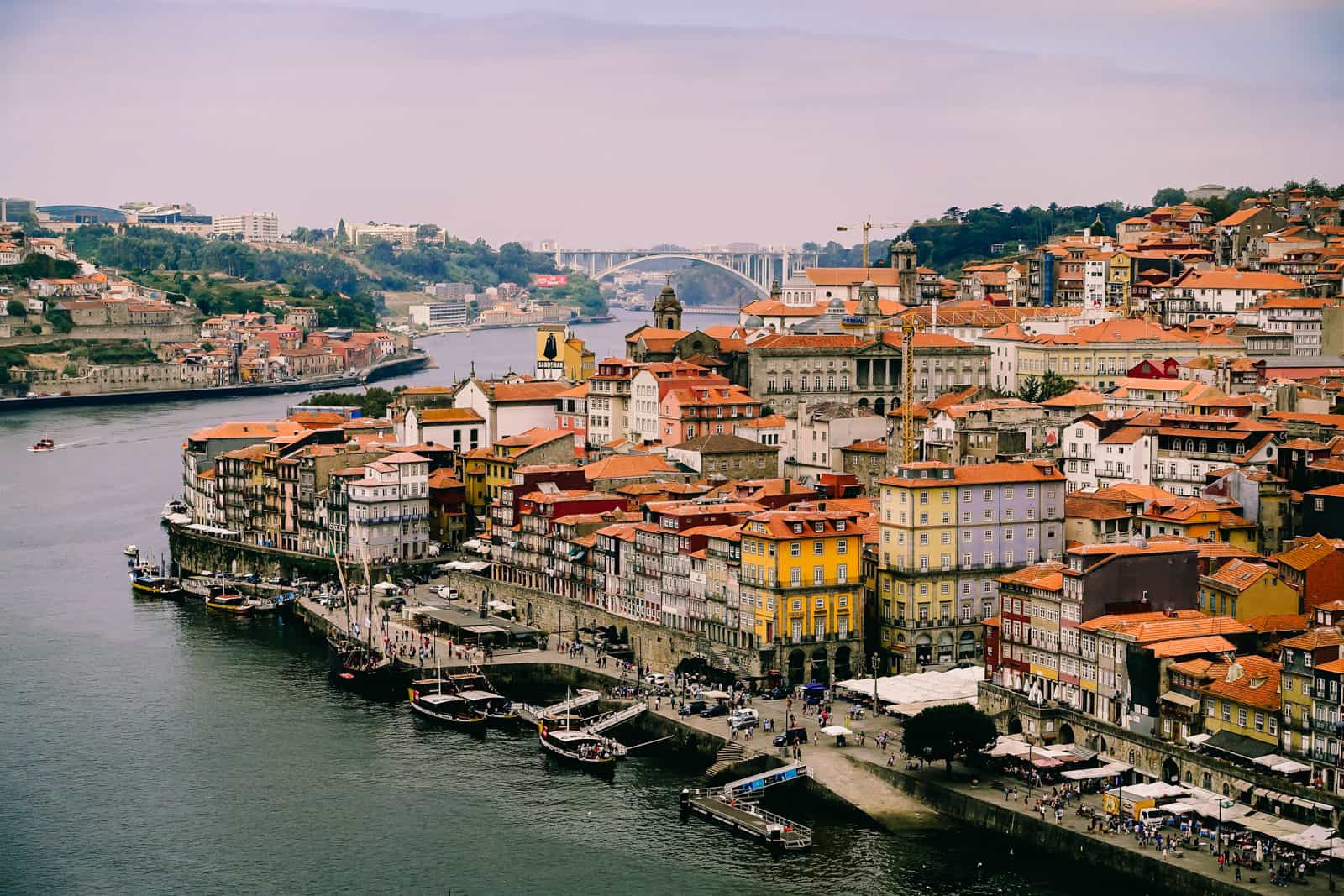




what to expect.
Miradouros (viewpoints) scattered across the seven hillsides of Lisbon overlooking the dense urban sprawl of red terracotta roofs dotted with occasional blotches of pink-flowering bougainvillea and palm trees
Ancient cobblestone villages with beautiful cream-coloured plazas and multi-storied town houses lavishly decorated with azulejos (shiny, colourful tiles)
Start every day with some pastel de nata, a Portuguese pastry with creamy custard and flaky crisp pastry – eaten hot with a sprinkling of cinnamon
Porto sprawling on the sloping hillside rising from the banks of the Duoro River and terraced vineyards sloping up the valley to either side of the river in the Duoro Valley
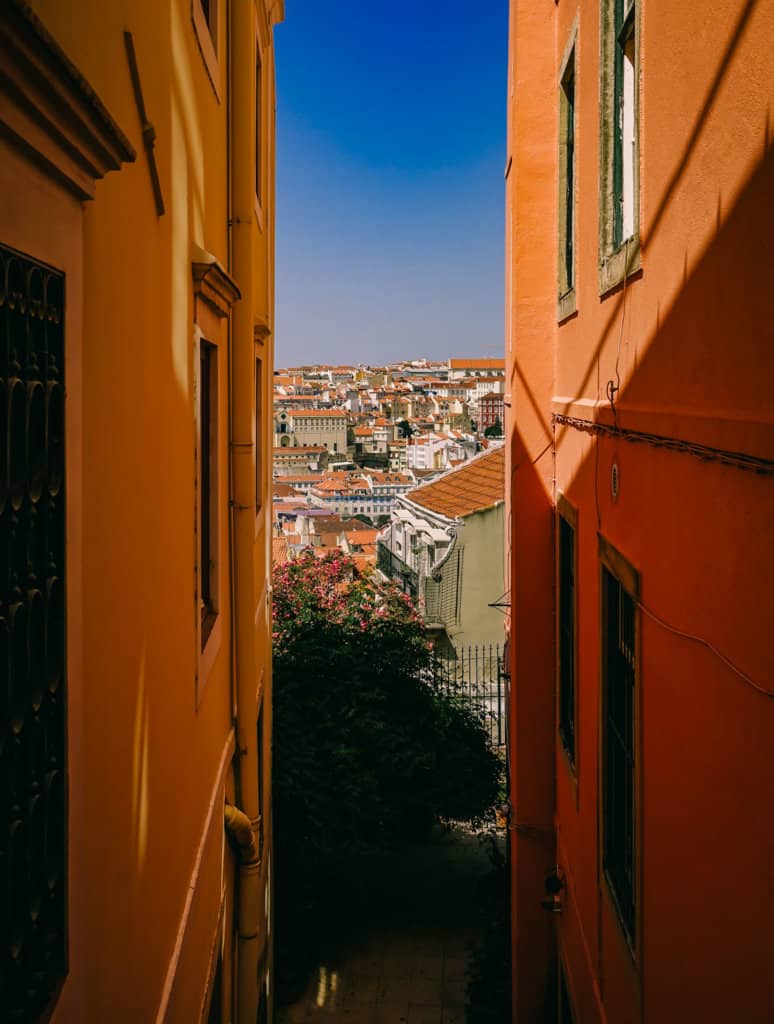
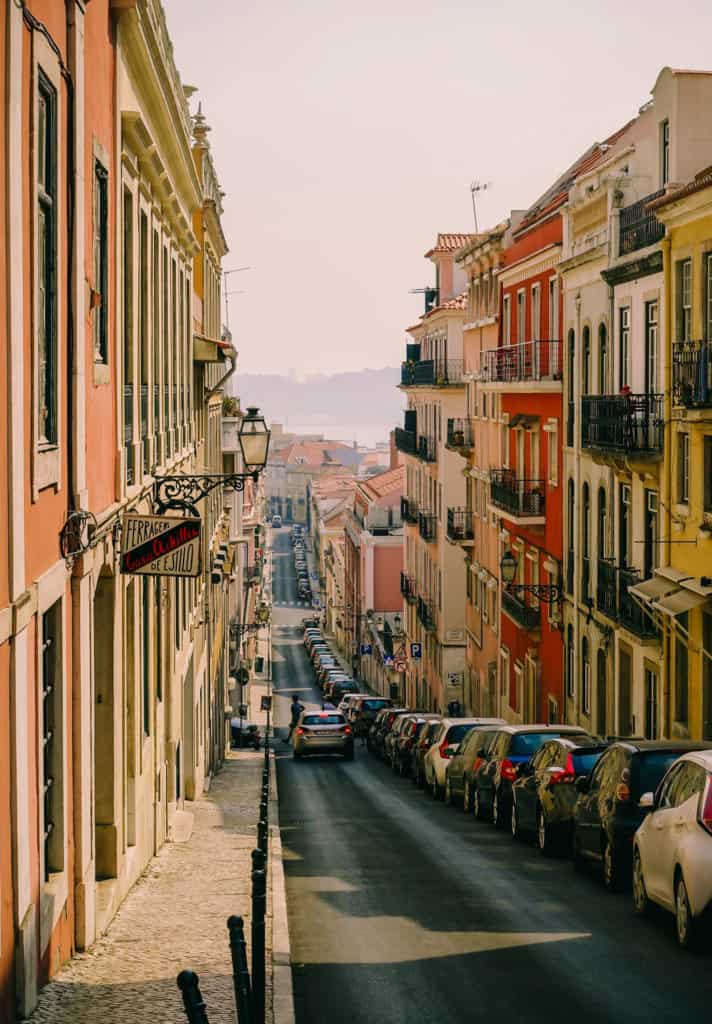
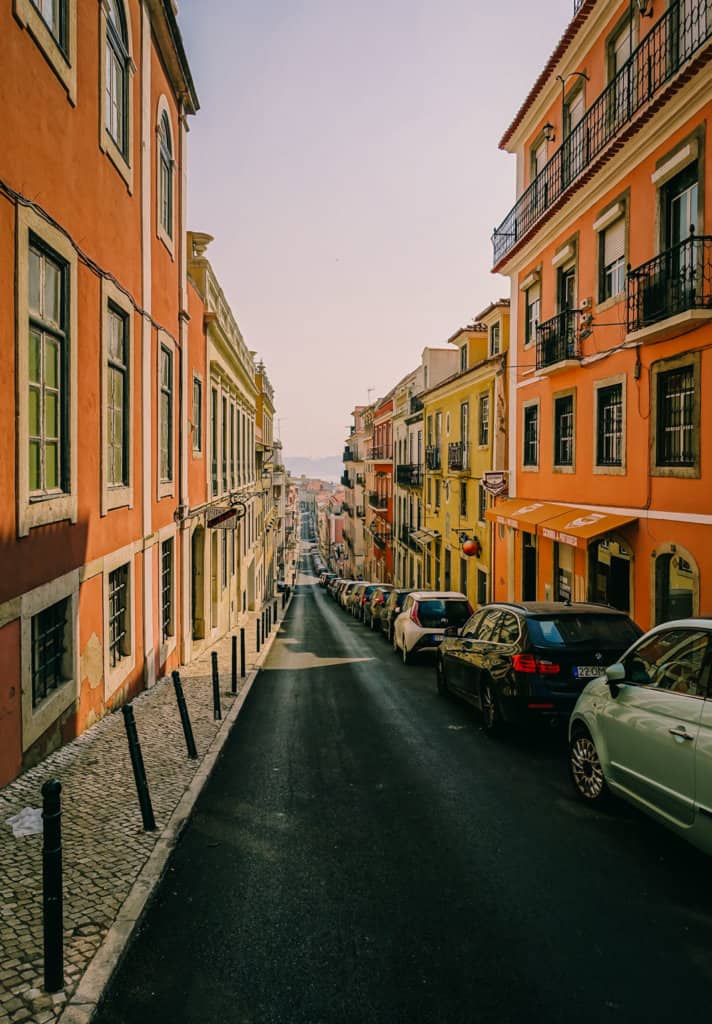
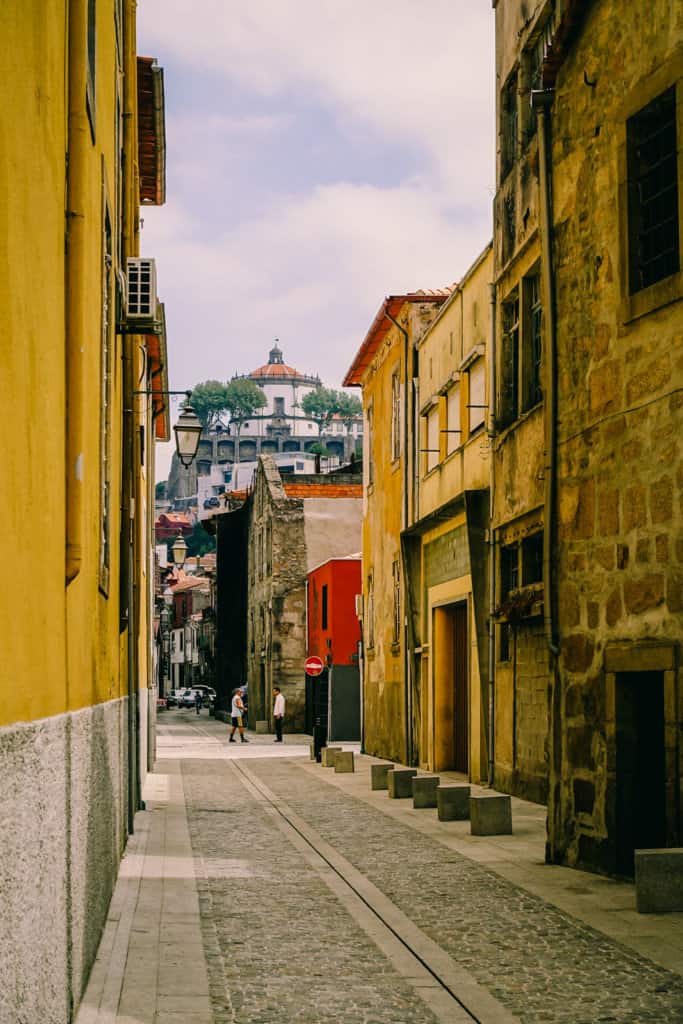
Colourful multi-storied townhouses lining the narrow cobbled alleyways.
On the quest for the creamiest pastel de nata in Lisbon
“Think of Barcelona as a beautiful, self-assured diva. Lisbon on the other hand is just as beautiful but still blissfully oblivious to its charms,” our friend said. With that in mind, our expectations were so high when we set off for Lisbon, situated on the west coast at the mouth of the Tajo River that was our starting point for a road trip across Portugal, that I feared they would be promptly dashed. I was wrong. The more we saw of Lisbon in fact, the less I understood why the city has seen an influx in tourists only recently. I can only think of its somewhat isolated location at the westernmost tip of Continental Europe for a reason because the city’s densely packed quarters oozed an unvarnished, undestroyed authenticity that is difficult to find elsewhere.
Equally inexplicable, from a tourist’s cursory glance, is the decline in the resident population from 800.000 in the 80s to currently around half a million. After just four days I was ready to move into one of the multi-storied townhouses lining the narrow cobbled alleyways that are beautifully decorated with the colourful tiles Lisbon is famous for. As contradictory as this may sound, now is the time to visit, before subliminal hate towards Airbnb apartments signals a growing weariness of tourism.
But then again Lisbon might manage a deluge of tourists better than Barcelona or Venice that appear to struggle with their popularity. At the moment anyway, Lisbon appeared to profit from the tourist dollars that were used to give the city a face-lift or complete overhaul in fact. But rather than destroy its individuality and charm, the works invigorated the old districts. The lustrous, picturesque facades that hide so well the need for renovation of the buildings they adorn were carefully restored, old houses have been remodelled, and the historical Mediterranean and Arabic influences mingled naturally.
Locals told us that the speed and vigour of these changes were astounding, almost it seemed as if Lisbon wanted to gloss over decades of neglect and indifference overnight.
Uber is cheap in Lisbon and a ten-minute ride each morning took us from our accommodation in Doca de Alcântara into the city centre to Arco da Rua Augusta on Praça do Comércio. Portugal’s capital is small and we walked the whole day, which for a city this size is undoubtedly the best way to ‘feel’ the place. Occasionally – for the experience and because our feet were sore – we hopped onto one of the traditional yellow trams and slid back and forth on a smooth wooden bench as the tram wheezed and rattled up a steep, winding slope to the next miradouro (lookout).
A ride on line 28, the most picturesque tram route that traverses several of the most popular bairros (neighbourhoods) and is infamous for pickpockets and being packed with tourists, is still a lovely experience but you should get on at the start of the line because seats indeed fill up quickly.
We started every day with some pastel de nata, a Portuguese pastry that was purportedly invented in the nearby Mosteiro dos Jerónimos in Belém. As hilarious as it may sound but before long the length of our stay could easily be measure by our expectations of these pastries. Initially, any custard tart will do, but once you’ve eaten your way across the whole of Lisbon in search for the creamiest custard and flakiest crisp pastry – eaten hot with a sprinkling of cinnamon – your expectations of the next pastéis fix evolve rapidly.
Our quest of the best pastel de nata in Lisbon was a yummy one. Lisbon in August was very hot indeed and we adopted the South European daily rhythm with ease, ate breakfast when colleagues in the office would normally holler ‘lunch time’ across the corridor, napped in the early afternoon when the sweltering heat turned the glassed tiles on the footpath into hotplates and showed up for dinner when we’d usually waddle off to bed.
In the late afternoon still, as we walked towards Castelo de São Jorge the heat wafted across the pavement and lingered heavily in the maze of steep, cobbled alleyways crisscrossing Lisbon’s oldest neighbourhood, Alfama. It came as no surprise then that we crossed under many laundry lines stretched across the narrow alleys between cast-iron French style balconies with a teddy bear hanging out to dry next to knickers and tea towels, because even a sogging wet woolly sweater (though I doubt the Lisboetas – people of Lisbon – own such a thing) would be touch dry in a half-hour.
One of Lisbon’s nicest features is the many miradouros (viewpoints) scattered across the seven hillsides overlooking the dense urban sprawl of red terracotta roofs dotted with occasional blotches of pink-flowering bougainvillaea and palm trees. From the sea of red tiles stretching down to the Rio Tejo, the longest river on the Iberian Peninsula, you’ll easily pick out the white dome of the Pantheon in Alfama and several church spires. We thought that Miradouro de Nossa Senhora do Monte in Graça offered some of the best panoramic views of the city that more than compensated for the uphill scramble to the lookout.
If you want to do some shopping (be aware that I’m certainly no expert on that topic as we hardly ever shop on our travels and Lisbon was no exception) I can recommend Embaixada, a concept store in a XIX century Palace in the trendy neighbourhood of Príncipe Real north of Bairro Alto that combines shopping with historic architecture and local culture, craftsmanship and design. You’ll find light-flooded local designer boutiques with gorgeous herringbone parquet flooring and a cafe around an inner courtyard and a grand staircase that leads up to the second floor with more shops.
When the sun set, after a full day walking the alley, and tourists and locals alike flocked to the sidewalk tables sprawling onto the shiny glazed mosaic tiles, the Fado tunes would waft into the hot summer’s night from inside a dimly lit bar. This style of music is very popular in Lisbon but the mournful, melancholic sound didn’t appeal to us much and in my eyes seemed oddly out of place in this otherwise cheerful, vibrant city.
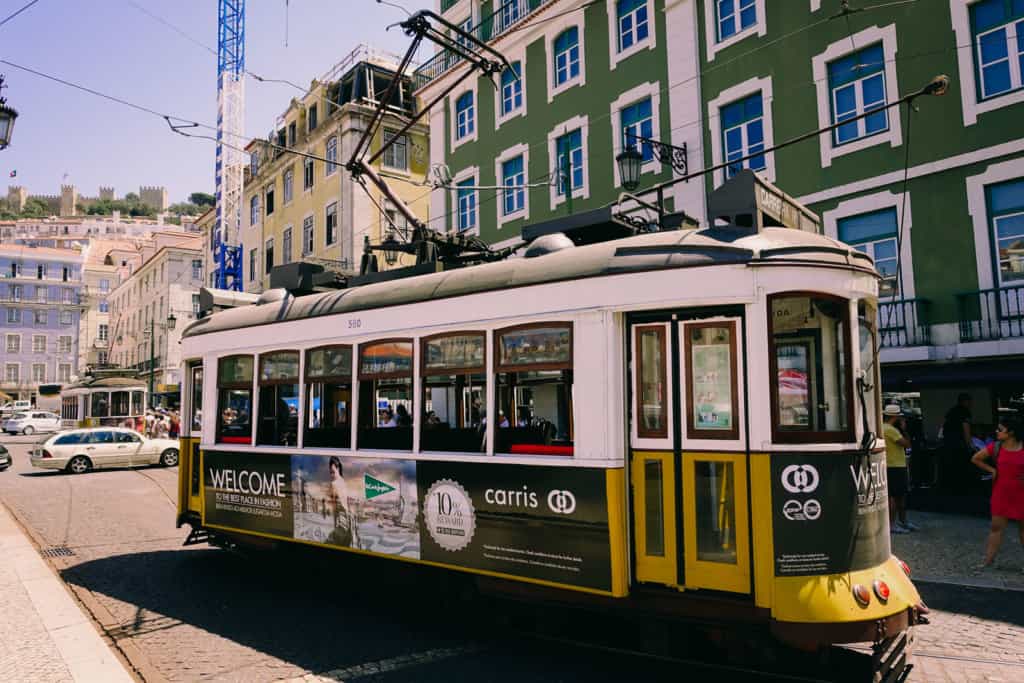
We often hopped onto one of the traditional yellow trams and slid back and forth on a smooth wooden bench as the tram wheezed and rattled up a steep, winding slope to the next miradouro (lookout).
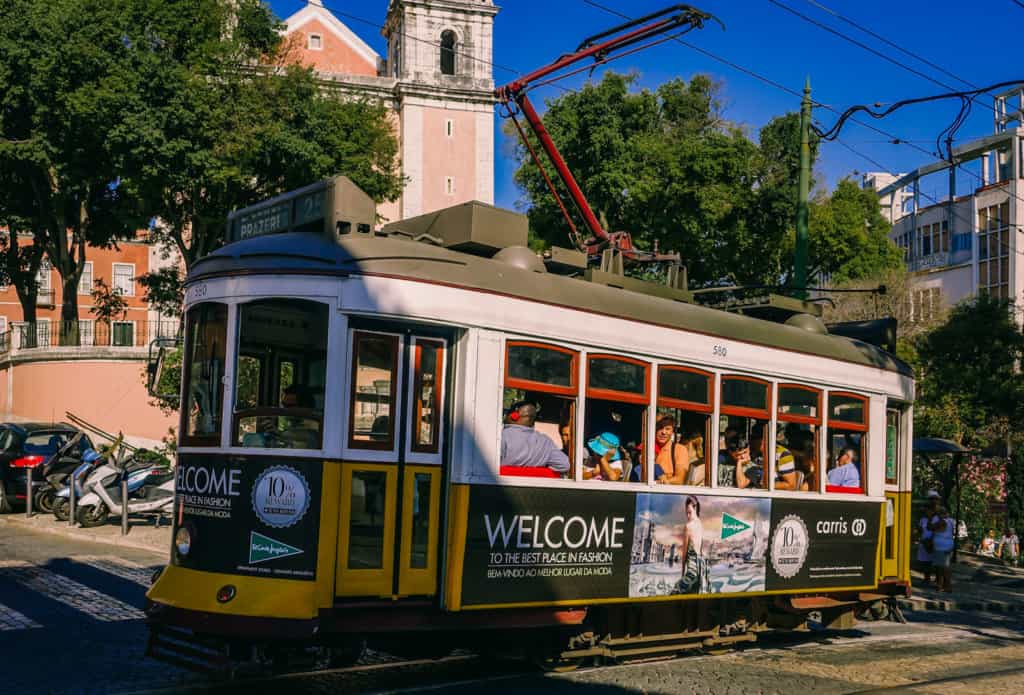
Belém
Our ongoing search for the best pastel de nata in Lison led us to Belém, 6 kilometres west of Lisbon. At Pastéis de Belém they make these delicious tarts since 1837 and their outstanding quality is well worth the ten-minute wait crowded in front of a busy counter. Most guidebooks in their paragraphs on Belém will of course mention the Mosteiro dos Jerónimos, a UNESCO World Heritage Site, first, and the pastries second. Admittedly our priorities were different but we were certainly also keen to visit this monastery of the 16th century that is also called Hieronymites Monastery and as by a miracle withstood the devastating earthquake of 1775 almost unscathed.
We strolled along on the outside of the building first, to the ornate south portal, a side entrance to the right of the main entrance that is considered a splendid example of Portuguese Late Gothic Manueline architecture. Despite its enormous size, the construction looked very graceful thanks to the elaborate ornaments – delicate statues, gables, pinnacles, cherubs, and arches – that adorn the white, unsoiled limestone facade glistened like precious marble.
When we entered the church, which is free of charge, through the western portal I was surprised at how gloomy its three 35m high naves appeared despite the glaring sun filtering in through elongated, colourful glass windows and casting an orange-tinted glow over the white stone interior. Six slim pillars adorned with chiselled ornaments stretch upwards into the ceiling and spread into fine strands that traverse the vault-like a petrified spider web. On our way out, we passed the life-size stone replicas of Vasco da Gama and Luís Vaz de Camões who lie on their respective tombs to the left and right of the entrance with their hands folded in prayer.
The gloomy, devout atmosphere disappeared the instance we walked into the large two-storied Manueline cloister of the monastery that surrounds a square inner courtyard (55 × 55 m). As we waited in line to proceed further, my gaze wandered across the honey-stone arches and balustrades that are richly decorated with pointed turrets, pinnacles, the royal coat of arms, and gargoyles. It made me think of One Thousand and One Nights and fairy tale castles, and how this would be the perfect setting for a garden party when shortly before sunset the slender pillars between the arcades would throw long narrow shadows onto the polished cloister floors.
Not far from the monastery, the Torre de Belém, a fortified, four-story tower sits on a small island just off the river shore. It’s a tourist trap of the worst kind (it actually does trap you on top of the tower) but as the queue was reasonably short we joined against our better judgement and regretted almost every minute. The wait for going up and down the one-way winding staircase is ridiculous and as there’s hardly anything to see inside the tower and the view from the top is mediocre at best, I definitely wouldn’t recommend you to visit.
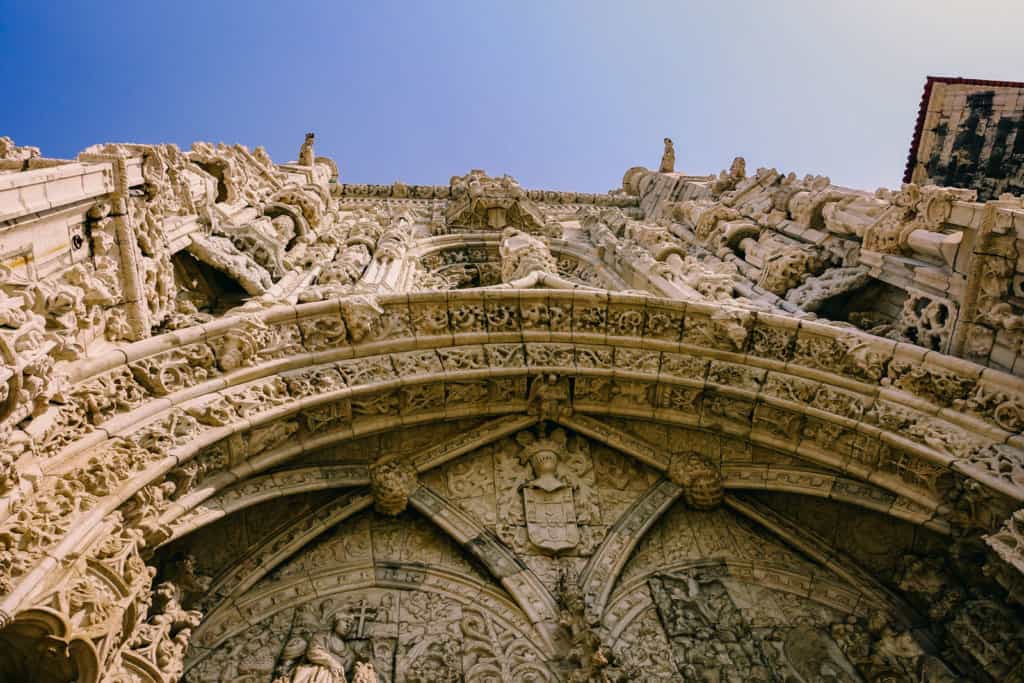
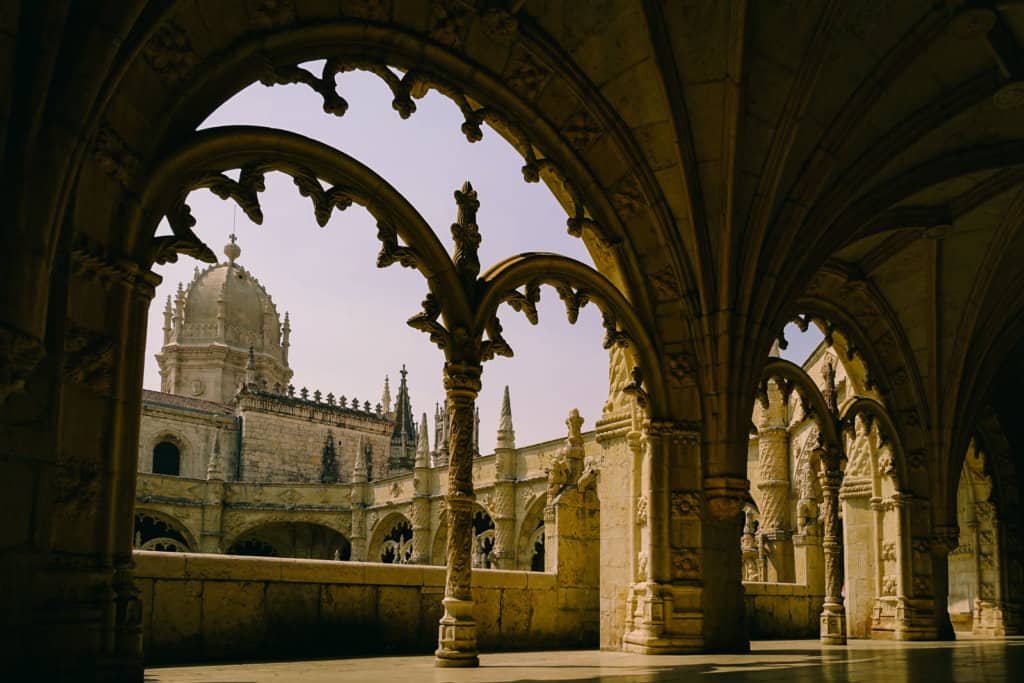
Sintra
A day trip to Sintra, 25km northwest of Lisbon, on the other hand, is a wonderful outing. It’s almost like a Disneyland outing for adults with just as much fun but one that makes you appear culturally interested and educated, not childish. Up in the densely vegetated Sintra Mountains, the Portuguese royals and governing elite created a fairytale summer retreat that in parts made me doubt the sanity of their architects. But then again the prevalent German no-frills, down-to-earth attitude is particularly unaccustomed to such opulence. It takes an insane German – the fairytale king, Ludwig II of Bavaria who commissioned Neuschwanstein Castle near Füssen and was suitably called Mad King Ludwig- to achieve this level of creative extravaganza; or as a German might say, madness.
Yet even he couldn’t come up with anything resembling this Alice in Wonderland park, with tunnels, grottoes, wells, fountains, and lakes, that surrounds the Quinta da Regaleira, a palace from the early 20th century that was our first stop in Sintra. The Castelo dos Mouros (Moorish Castle), up a steep but beautiful trail through the wooded hillside starting at Rua Marechal Saldanha, that was our next stop was completely different with its battlements and sturdy walls. The ruins that remain of the castle dating back to the 8th or 9th century didn’t capture our attention for long but we set off for a walk along its well-preserved defence walls with childish enthusiasm. This was my favourite part of the whole day and the views of the densely vegetated slopes dotted with palaces and transitioning into level meadows that spilt forward towards the Atlantic Ocean were outstanding.
When we thought that Quinta da Regaleira was something out of a fairytale, we hadn’t seen the Palacio da Pena, a former summer palace of the royal family, yet that is the epitome of delightful craziness. It was an incredible sight and I believe there’s no architectural style that adequately describes the singularity of this palace. Imagine a little kid in your family (female preferably because I believe we have a greater affinity to colour) is given a colour by number page with a fairytale motive, a large paint box, and a sticker album full of stickers of gargoyles, grapevines, turrets, and crenellations. Then you tell her to give it her best go and also use every single colour in that paintbox and all stickers. Whatever painting she’ll end up with will bear a striking resemblance to the Palacio da Pena.
We travelled to Sintra by train and I wouldn’t recommend going by car if you don’t plan to arrive very early or out of season as the parking situation is disastrous. And if you have a sweet tooth, you may want to skip lunch in favour of queijadas and travesseiros (local sweets) from Casa Piriquita. We did and I think that may have been my record in pastry cramming.
We were sad to leave Lisbon behind and almost reluctantly exited the city on route N6 that winds along the shore to the charming seaside town of Cascais and continued further on route N247 up the west coast to Cabo da Roca. The cape marks the westernmost point of Continental Europe and is almost but not quite as inconspicuous as Cape Agulhas in South Africa, which marks the southernmost tip of the African continent. Many guidebooks suggest it’s a sight worth visiting but essentially it’s a lighthouse perching on the ledge of sheer cliffs plunging into the sea below and a large parking lot, no more.
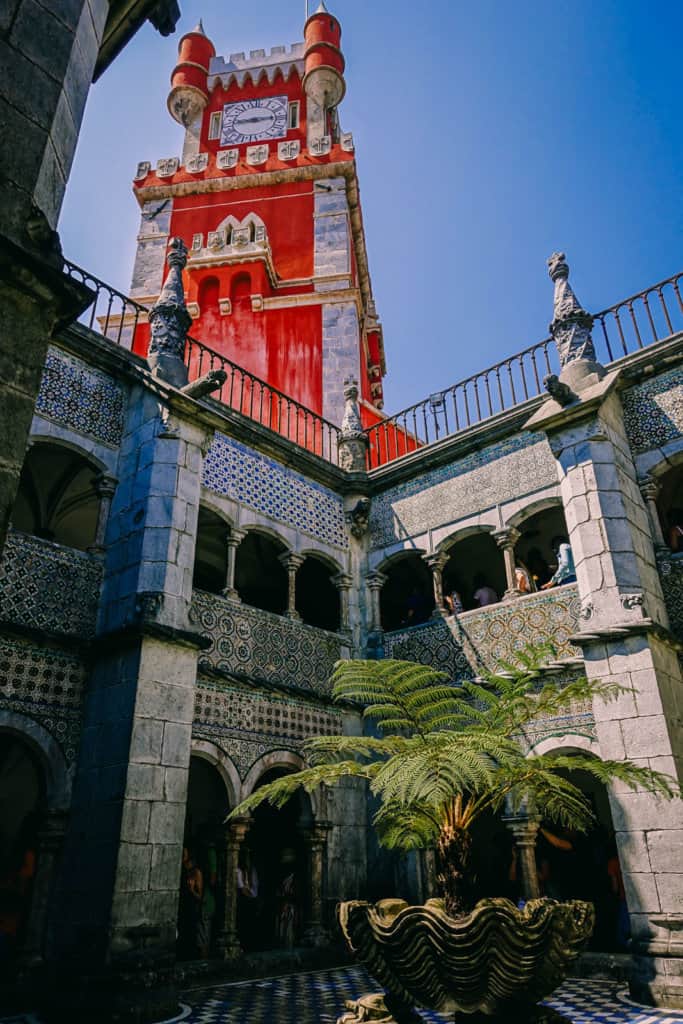
Up in the densely vegetated Sintra Mountains the Portuguese royals and governing elite created a fairytale summer retreat that in parts made me doubt the sanity of their architects.
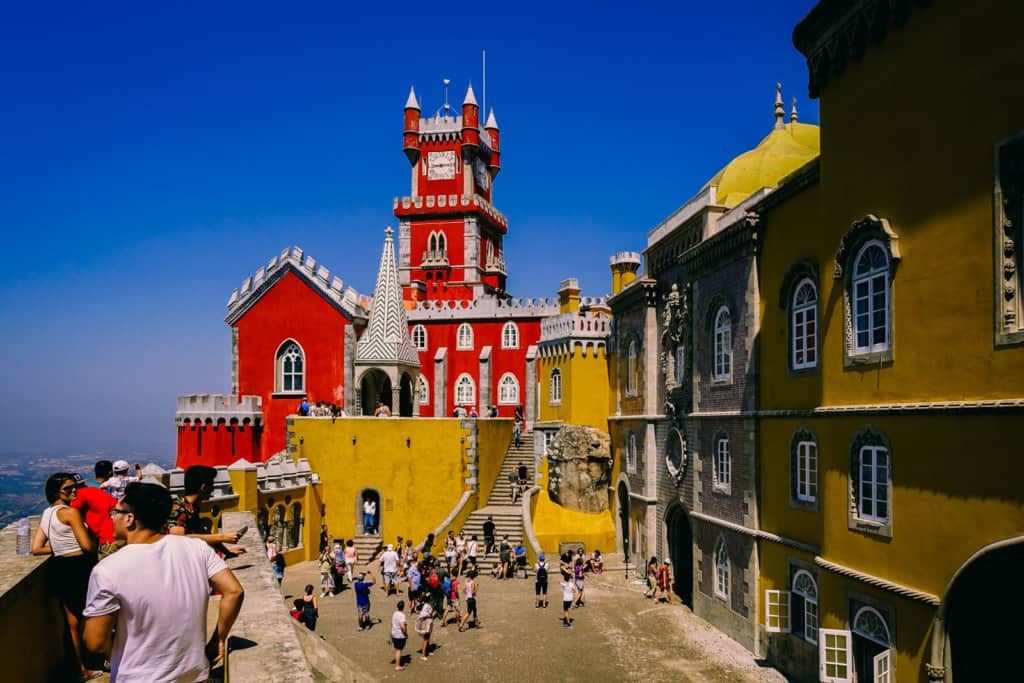
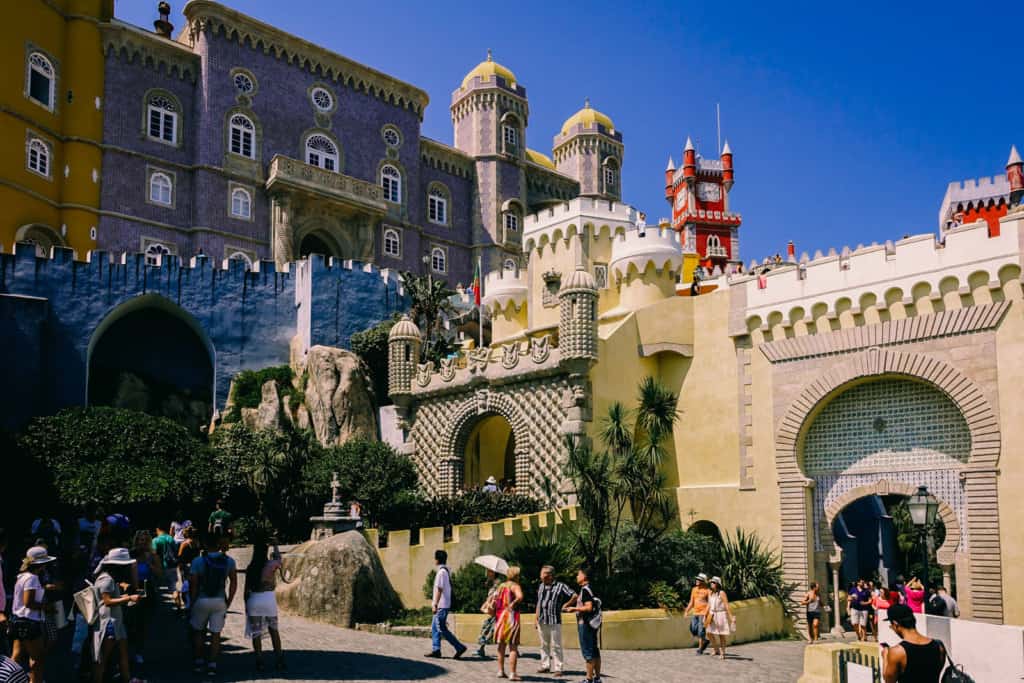
Porto
Coming from the south, we entered Porto, the second-largest Portuguese city, via Ponte de Dom Luis I. The bridge spans the Duoro River where it winds between Vila Nova de Gaia on its southern shore and Porto sprawling on the sloping hillside rising from the opposite river bank. We were stuck in bumper-to-bumper traffic crawling across the lower deck of the metal arch bridge but were amply entertained by the sight of the city, which seemed oddly familiar. Maybe because the colourful houses with red terracotta roofs piled on top of each other in an authentic jumble of semi-derelict and beautifully renovated homes in the central neighbourhood of Ribeira bear a striking resemblance to Valparaiso in Chile, though Porto is of course much smaller.
We checked into our Airbnb apartment and when we crossed the bridge to Vila Nova de Gaia, famous for its port wine cellars, on foot again later that night, on its upper deck that is shared by a light rail line and pedestrians, the Duoro River sparkled with the lights on the docks reflecting in the purple-black water surface in blurred golden bubbles. The southern riverbank was almost deserted by night. We sat on the docks and listened to the Duoro sloshing against the quay and the happy sounds of nightlife wafting across from Porto.
Walking back across the bridge, a building looking much like a honeycomb ablaze with light set on an elevation in Gaia caught our attention. It’s a monastery of the 16th century, the Mosteiro de Serra de Pilar, we found out and standing on its terrace the next day we discovered the best panoramic views of Porto nestled into the river loop yet. A 5-minute ride on a small teleférico (cable car) that runs from the monastery to the Gaia riverfront, while being indisputably touristy also offered a new perspective as we skimmed over the rooftops of elongated warehouses and port lodges into the inner sanctuary of the port wine. Not far from the lower cable car station, food stalls lined the waterfront and sold bulging ham and black pudding sandwiches that are popular in Porto, freshly baked olive bread, ham, and the best goat cheese we’d eaten yet. A half-wheel of the latter was the smallest quantity sold but lasted us barely two days.
In Lisbon, we had thought that August was an unfavourable time to visit Portugal because of the heat rather than the tourist crowds. In Porto however, almost every word spoken in public was French, not Portuguese, and that was almost as irritating I imagined as visiting Majorca’s German-infested Ballermann beaches where Heino and Helene Fischer blare from loudspeakers. To escape this overwhelming stream of selfie-stick waving French, we went for a run along the Duoro River every morning, to the mouth of its estuary, which opens into the Atlantic Ocean at Foz do Douro (‚Mouth of the Duoro’), an elegant, wealthy seaside suburb, westwards of the city centre.
We were surprised to see fishermen return to the river bank with their first catch of the day this close to the city but then again fishing may well be the livelihood of quite some townspeople because where the salt water and fresh water flow into each other a quay stretches boldly into the estuary and all along it more fishermen stood shoulder to shoulder behind fishing rods, waiting for the fish to bite. Unlike me, they seemed completely unfazed by the fishy stench of the algae clinging to the quay wall that was exposed by the tide and the irritating screeches of seagulls circling above.
After the runs, we started from our accommodation opposite Jardim das Oliveiras, a few steps from the Torre de Clérigos and dove into the labyrinth crammed with cobbled alleyways sloping towards the river to grab some pastéis de nata. Pastries in hand we then walked to Sé, an imposing Catholic church dating back to the 12th century to savour the wonderful views of the city and the river from its terrace for breakfast.
Initially, we were surprised that much fewer house facades than in Lisbon were decorated with azulejos (shiny, colourful tiles), but when we stepped inside the Beaux-Arts São Bento station hall I thought I understood why. It appeared all effort had gone into lining the station walls with beautiful azulejos friezes and panels depicting historic scenes in fascinating detail. What was less surprising was the overabundance of wine shops selling port.
All friends visiting us, after some time sitting in our kitchen, remark on the sizeable collection of booze in our glassed kitchen cabinet with curiosity. ‘For someone who doesn’t drink you’ve got a fair selection hidden in there,’ they’ll say. Then I’ll dart the ‘You see, it’s stupid’-look at Tobi who will retort, ‘Every household needs a bar’. I don’t mind the bar but Chilean pisco, rum from Réunion, schnapps in various flavours, and other carefully selected spirits are slowly taking over the limited space we have for crockery.
Then we came to Porto and Tobi disappeared into Garrafeira do Carmo, which after countless hours of online research was his choice of port wine shop – a tiny one-room business that I left after 5 minutes to make room for paying customers and waited outside for 70 minutes, at the time thinking that Tobi would come out any minute, disillusioned. Instead, he added three bottles of port to our collection that will go untouched until some kind soul visiting us takes pity on them.
On our last night in Porto, we drove 45 minutes eastwards to Amarante for dinner, which admittedly is a long journey for a meal to make if it were any ordinary meal in an ordinary restaurant, which the Largo do Paco in Amarante, a mustard yellow Baroque building with neoclassical elements dating back to the 16th century, towering above a loop of the Rio Tâmega, is not. The former palace was turned into a 5-star hotel and one Michelin star restaurant that also offers vegetarian options, which sadly among Michelin star restaurants still seems to be highly unusual. At least hours of online research had only produced the Largo de Paco as a vegetarian-friendly place.
We started with cocktails on the terrace just as the sunset painted the opposite Baroque monastery São Gonçalo (its cloistered courtyard is open to the public) and a famous 18th century stone bridge spanning the Tâmega River a warm honey colour and other dinner guests arrived, all dressed in rather formal attire. I thus expected the restaurant interior to also be formal and painted in subdued colours but instead, it was like a set taken straight from Alice in Wonderland with colourful chair covers, wine glasses, and walls, and fancy chandeliers. I wondered whether an offspring of an architect from Sintra had gone into interior decorating or this peculiar fascination with Alice’s wonderland existed everywhere in Portugal.
This was our first visit to a Michelin star restaurant and we loved every minute of our visit. The food fitted the decorating style perfectly, for every single dish was a fanciful composition of blobs, spots, and form arranged on pebbles with tweezers, layered, or spread across an entire plate in streaks and swirls. Every course was creative yet delightfully uncomplicated in taste. The service was impeccable but the ambience a little strained. That wasn’t owed to the waiting staff however but the other guests, who were exclusively French. They seemed far more experienced and thus critical in their assessment of Michelin star restaurants and tonight their expectations were not met as their pained expressions and palpable discontent suggested.
Completely unable to relate to their disappointment, Tobi whispered, ‘It seems like they had an accident in the kitchen and the cook mistook citric acid for salt.’ I almost burst out laughing and trying to stifle a highly inappropriate laughing fit with a tissue emitted rather loud snorts, which a couple with a teenage daughter took rather personally, I’m embarrassed to admit. They left within minutes, before dessert and audibly complaining to the head waiter (I hope about the food not the table on the far right at the back). It’s a real shame they missed out on dessert because that was, as always, the best part of the meal and followed by the sixth or seventh amuse-bouche – a plate full of chocolates and tiny pastries that easily matched up to Zurich’s best chocolateries and patisseries.
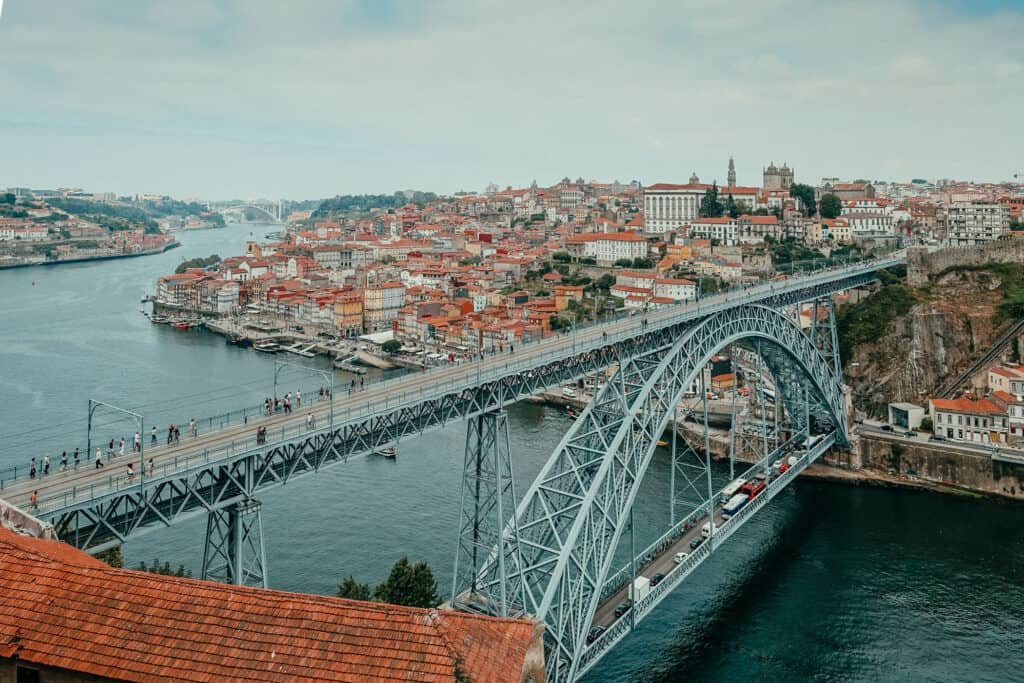
Ponte de Dom Luis I bridge spans the Duoro River where it winds between Vila Nova de Gaia on its southern shore and Porto sprawling on the sloping hillside rising from the opposite river bank.
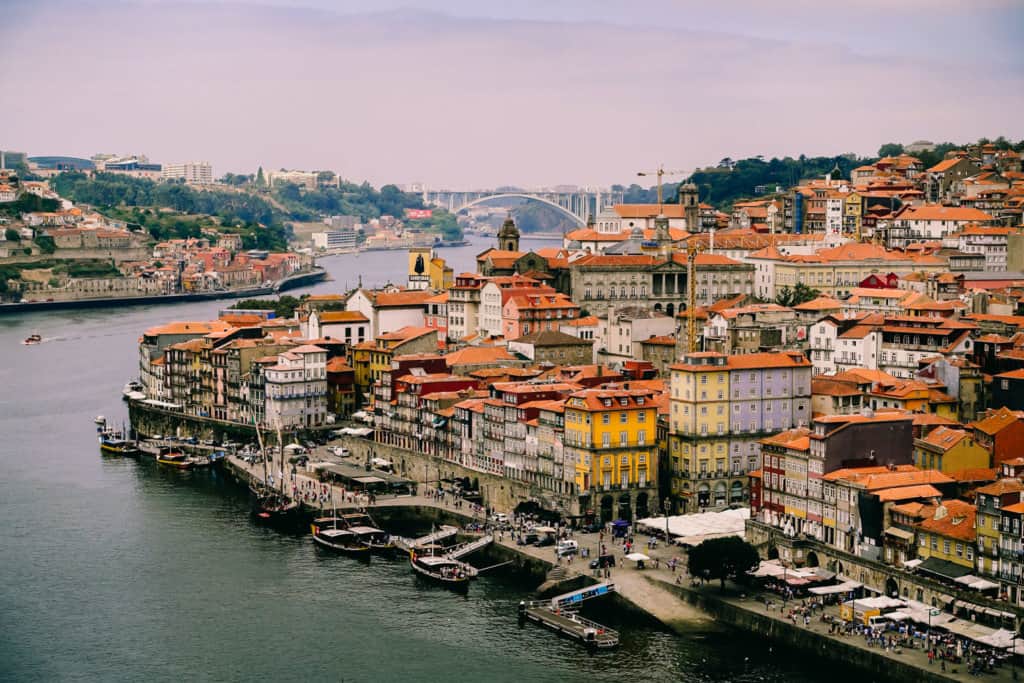
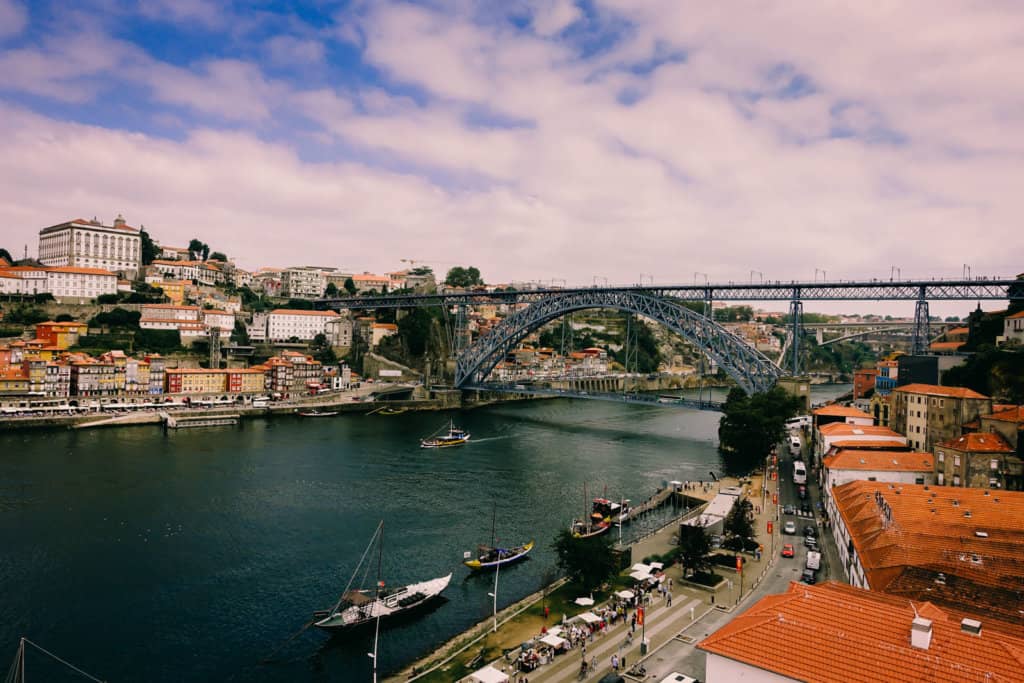
Duoro Valley
We had deliberately sacrificed possible hiking tours on this road trip to time and luggage constraints but still wanted to spend a day at least in Portugal’s highest mountain range, the Serra da Estrela mountains 190km south-east of Porto. Yet instead of driving straight to the Casa das Penhas Douradas, a 4-star mountain resort at 1500m, that would be our next stop, we spent a half-day cruising through the world’s oldest wine region the Duoro Valley, on route N-222 from Peso de Regua to Pinhao along the southern riverbank of the Duoro River, which was elected world’s best drive in 2015.
The terraced vineyards gently sloping up the valley to either side of the Duoro, the small villages, and whitewashed quintas (vineyards) along this 27km stretch were declared a UNESCO World Heritage Site in 2001. The area is world-famous for its port wine but was surprisingly devoid of tourists, and its quintas were oozing the expertise of 2000 years in wine production but modest in size – unlike some phenomenal vineyard estates in Australia. It seemed the long history in the Duoro called for whitewashed walls rather than fancy facades. From a distance, the valley is covered in a network of neatly laid out rows of grapevines winding up the terraced hillside. Yet close up I was fascinated by the gnarled, scrawny vines that bring forth such a splendid dark green leaf canopy and plump, sweet grapes.
After driving from Peso de Regua to Pinhao and back, with a few stops at quintas and short strolls through the vineyards, my butt was itching to get out of the car in Lamego, 10 kilometres south of the Duoro, for a zigzag sprint up the steps to Igreja de Nossa Senhora dos Remédios. It’s more than 600 steps to the top, so our initial sprint tired into a leisurely jog halfway up, which I disguised well as a sudden interest in the shiny blue and white azulejos decorating the staircase, stately pillars topped by life-sized statues and fountains with one-legged, water-spouting gargoyles. This staircase was, without doubt, the most elaborate and splendid flight of steps I’d ever seen and I rather expected the Palace of Versailles at its top than ‘just’ a church.
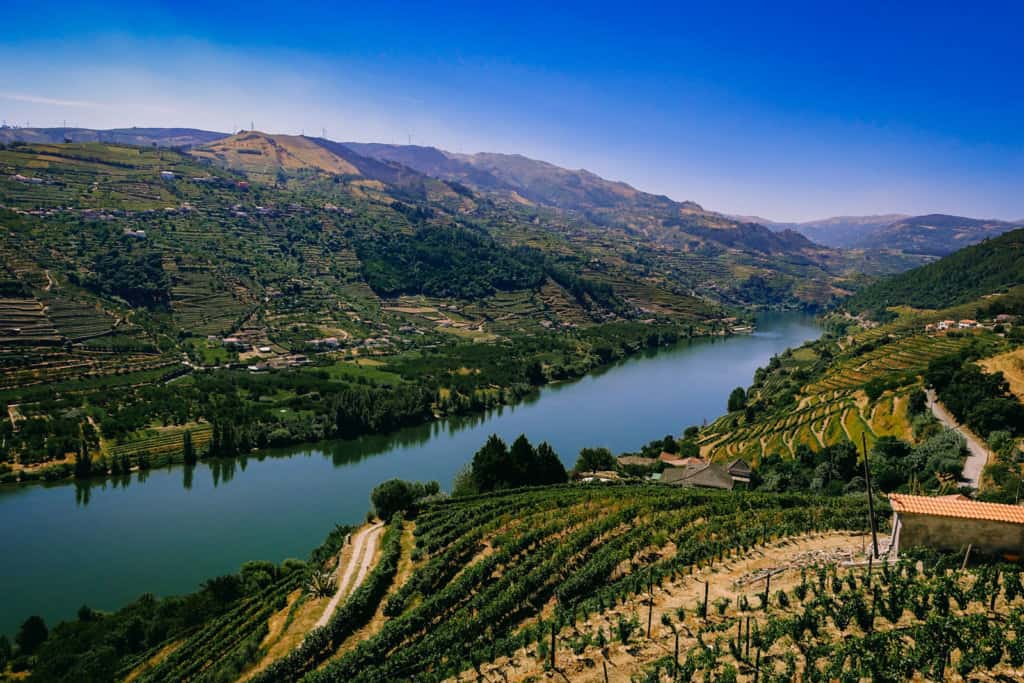
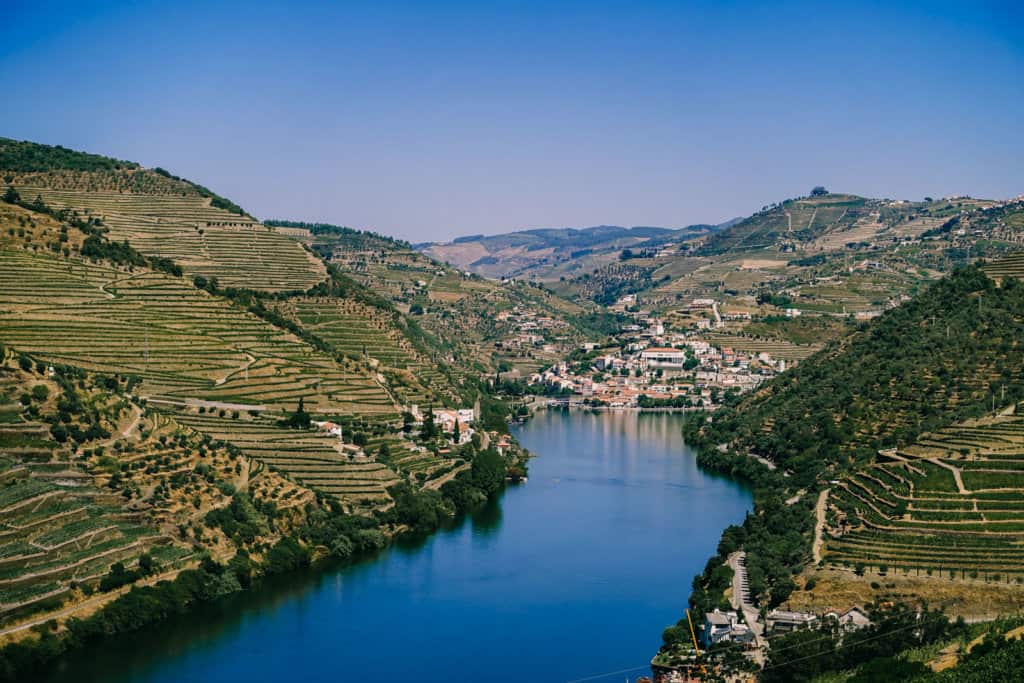
The terraced vineyards gently sloping up the valley to either side of the Duoro, the small villages, and whitewashed quintas (vineyards) along this 27km stretch were declared a UNESCO World Heritage Site in 2001.
Manteigas
In the late afternoon we climbed elevation steadily on the serpentine, very picturesque route N232 and shortly before arriving in Manteigas turned right on a small lane to Casa das Penhas Douradas. After the tourist crowds in Lisbon and Porto we basked in the tranquillity and solitude we found in the mountain range between Manteigas and Seia.
We met no one on our walks through the national park, only colossal foundlings chaotically strewed about on the barren, steppe-like mountain crests like wine gums that had tumbled out of the bag. These, and delicate rock formations and spectacular balancing acts of stone that the buffeting wind that was pushing grey clouds across the exposed landscape at breakneck speed had over time created by erosion.
At high altitudes, the sweltering heat of the previous days had given way to a crisp mountain breeze and when we returned to the resort, the other guests were already gathered in front of the fireplace and around bonfires outside. I’m a strong opponent of sudden temperature drops but strangely enough, the chilliness outside fitted the Casa’s cosiness well.
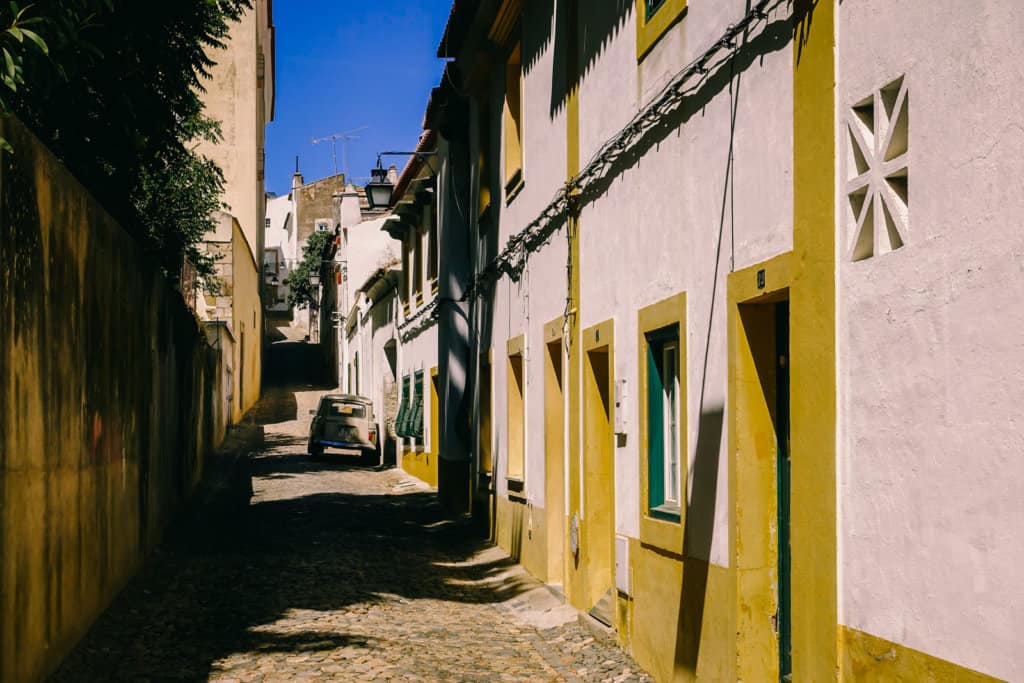
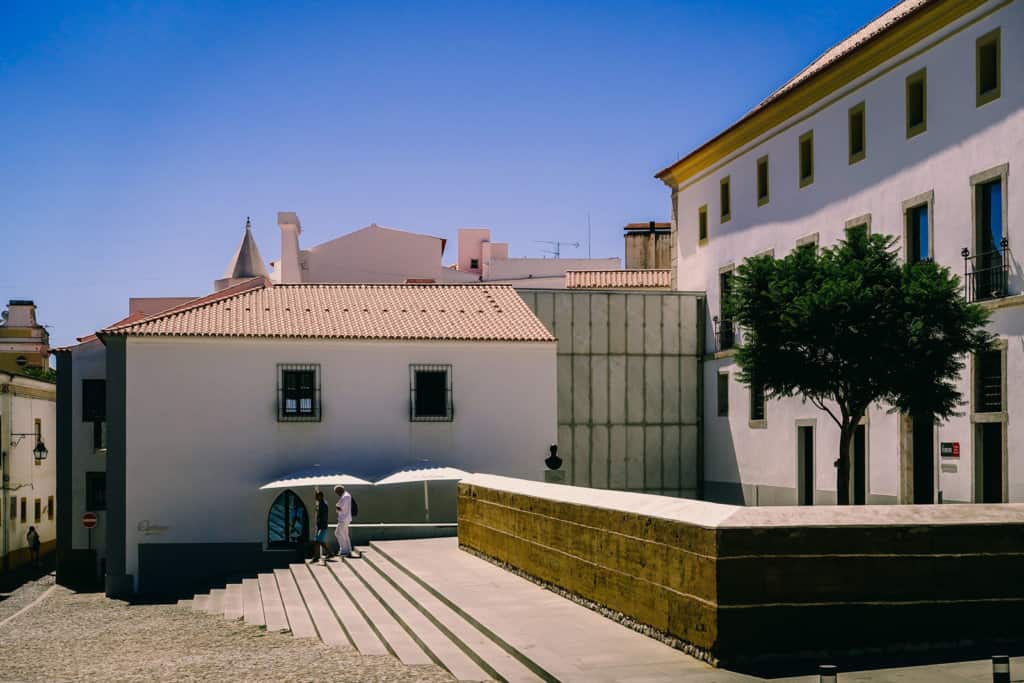
Algarve - Vila do Bispo
And the heat returned in full force anyhow, on the 560km drive to Vila do Bispo at the very southwestern tip of the Algarve, a half-hour drive southwest of Lagos. We picked this small fishermen’s village for its unique location inside the protected Costa Vicentina National Park near the Atlantic Ocean and beaches in the south and west. After 300km we stopped for lunch and some leg stretching in Évora. This well-preserved medieval town boasted the Aqueduto da Aqua de Praia’s (aqueduct of Silver Water), mighty arches spanning across the road, a beautiful town square dominated by Igreja de Sao Francisco, a sturdy church that rather resembled box-shaped fortifications, narrow winding alleyways, and one of the best-preserved Roman buildings in Portugal.
The Templo Romano (Roman temple) with 14 Corinthian columns would fit into the Forum Romanum in Rome just perfectly. In Évora the temperature hit 40 degrees, the locals had disappeared off the streets, and most tourists huddled underneath large umbrellas at sidewalk cafes, sipping chilled drinks and wiping away sweat from their face. Indeed I’m happiest when it’s hot but even I appreciated the shade in the Public Garden of Évora, yet less so the highly praised Pão de Rala (local pastry) and a marzipan cake with egg yolk filling from Pastelaria Conventual Pao de Rala. My sugar intake is atrocious and I will never say no to pastries but these I couldn’t finish, they were simply too sweet.
At the end of a long day on the road, we were happy to arrive in Vila do Bispo and move into our accommodation, a former fisherman’s cottage that looked just like any other in this pretty village full of typical whitewashed, low-rise cottages with light red terracotta roofs and coloured window frames lining narrow cobbled streets built around a 16th-century church. When there are no gardens and the houses are small, people spend more time in the streets. We watched as the laundry was hung out to dry, an elderly couple from across the alley shuffled off to the market and two of the crowd of sun-hungry surfers with shaggy salt-water hair that had descended upon the village in August walked past, probably in search of a vacant table in a seafood restaurant. The latter, to my undisguised delight, proved an insurmountable challenge in high season and I easily convinced Tobi that a fish dinner, no matter how good, wasn’t worth a 1-2 hour wait.
On our departure, our host implored us to visit Vila do Bispo again in September or October when the village empties and an unhurried normality returns, the temperatures drop below 30 degrees and the strong Atlantic Ocean gusts abate. Then, so he claimed, the restaurants at this remote south-westernmost corner of the Algarve would again belong to the locals. In August, however, the French tourist crowds we encountered in Lisbon and Porto were simply replaced (in equal numbers) by mostly overweight, pale-pink Brits in Sagres, Lago, and Luz.
These poor things looked like boiled lobsters with blistering shoulders and backs but were, as always, a great deal more charming than the French. Even the resorts dotting the landscape with a private golf course and a palatial white cobbled driveway lined by palms advertised ‘more than 300 available luxurious eco-resort units’ in English including a full English breakfast with marmalade and fish and chips from room service and condo neighbours from the island, but without the notoriously bad English weather.
But despite decades of recurring high seasons, Vila do Bispo and the other villages in this part of the Algarve have retained their authentic, laid-back charm. The elderly Portuguese still flock to the tiny weekly market and easily outnumber the tourists as they haggle over the first catch of the day and inspect the fresh fruit, trade gossip, and disappear into a small pasteleria next door for bread (or what we call South European air in a crust) and crispy pastéis de nata. Most stall owners still speak no English and communicate with hands, feet, and smiles, whatever it takes to make themselves understood.
Outside the national park, however, mass tourism has started to disfigure the gorgeous coastline with faceless concrete blocks adorned with hideous, multi-coloured one-man balconies. There you’ll find the typical tourist restaurants with annoying but multilingual rat catchers positioned in front, who fluently praise Wiener Schnitzel, Pizza, and Spaghetti Bolognese as, ‘very good food,’ in 20 different languages and wave sticky plastic-coated menus in your face.
Fortunately, such concentrations of mass tourism were still few this far west and the scenery, mostly barren steppe, was battered more by gusts sweeping across shrivelled straw-coloured tussocks with unrelenting force and bending gnarled silver olive trees inland than the effects of an influx in tourists. It was an arid, monotonous landscape of sand, dusty dirt roads, and scorched red soil but some plants persevered, like fig trees and cork oaks. Yet it was a scenery desaturated and when a flash of vibrant pink Bougainvillea splashed colour on the brownish canvas the effect was much like that of the rose in Pleasantville.
At the Algarve, we had hoped to find the kind of beaches that we miss dearly from New Zealand and Australia – empty, pristine, and remote. And indeed, the long, untouched stretches of sand strung along the west coast and stretching against the backdrop of steeply rising cliffs were empty but for some surfers and walkers strolling the beach, who were, like us, put off by a water temperature below 20 degrees Celsius more than the red flag flapping in the strong breeze warning of high surf or dangerous currents.
